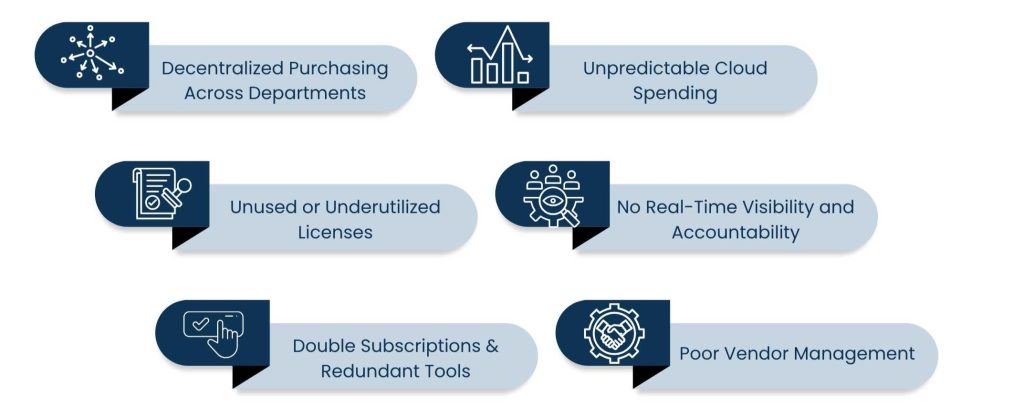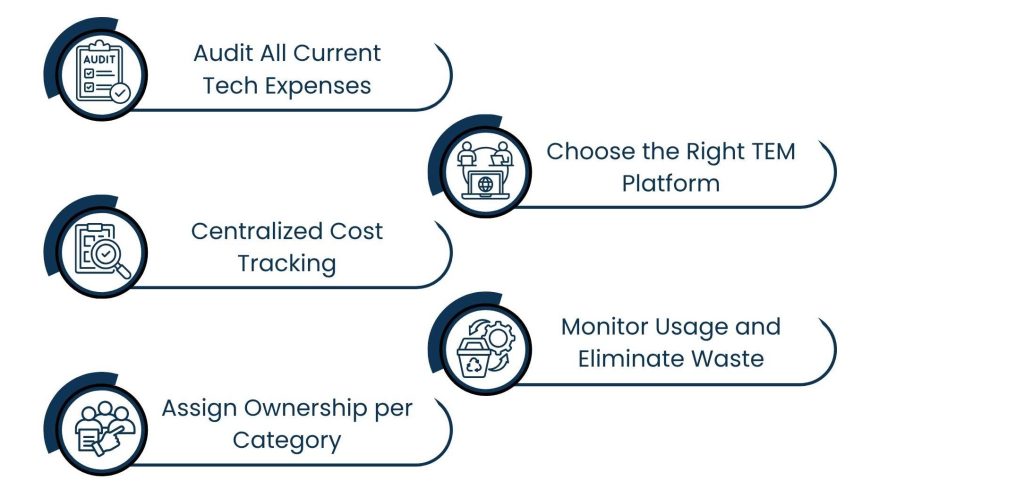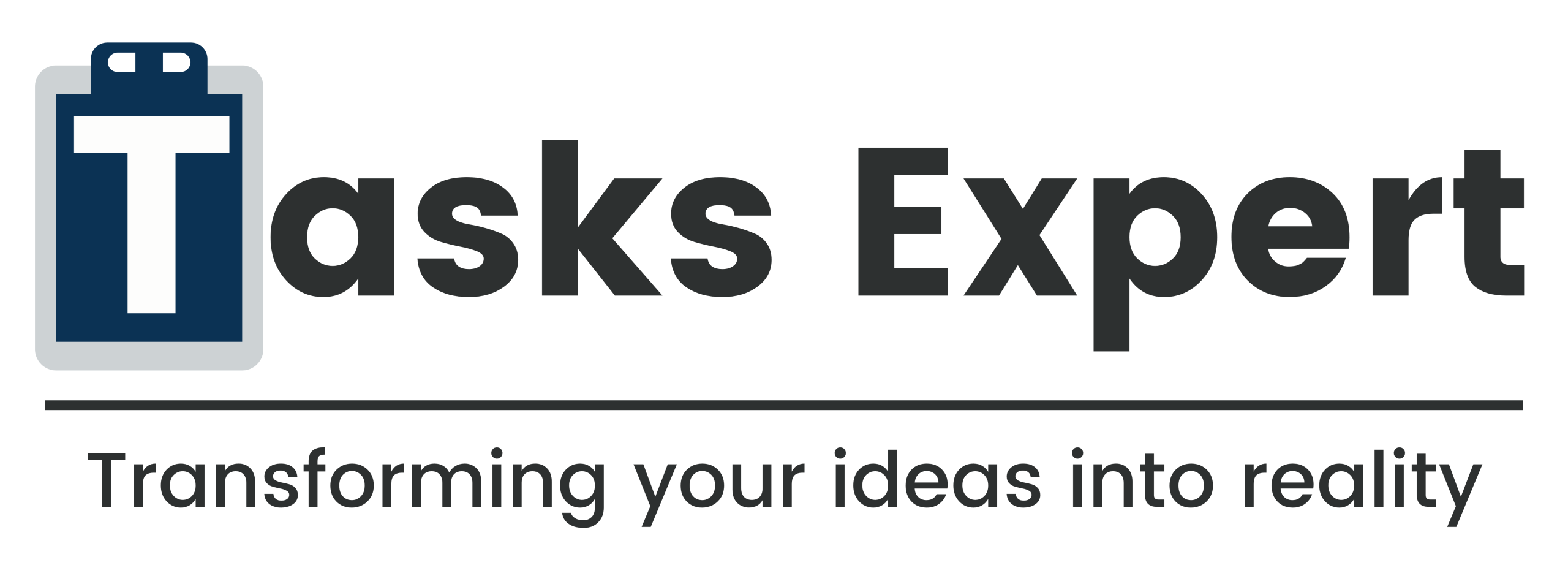Introduction
Technology Expense Management is the practice of monitoring, controlling, and optimizing all costs and expenses that are associated with the usage and delivery of technology in any organization. This encompasses everything from telecom and web offerings to cloud subscriptions, software licenses, hardware acquisition, and IT infrastructure spending. In a world where companies spend quite a bit on digital tools and platforms, “tech” expenses are no longer relegated to IT alone, and they now sit across both teams and budgets.
Without proper oversight, this can lead to disjointed spending, unused subscriptions, and overpaid contracts. So, that’s why a structured TEM system is a preferred option for many businesses to source all costs to one central view. Rather than file a swirl of spreadsheets and invoices, teams quickly realize the best strategy is to aggregate and report all data in one place in real time using technology expense platforms.
Technology Expense Management helps companies get the insights on how their technology budget is getting spent, and offers more intelligent financial decision-making. It ensures that every dollar spent contributes real value to the business. TEM brings a degree of visibility, control, and power to digital spend that never existed previously, whether an organization is a small start-up or multi-national.
Why Companies Are Losing the Battle With Tech Costs?
As businesses continue to adopt more and more digital tools and move more of their operations to the cloud, their technology costs are increasing dramatically, but visibility isn’t. What used to be simple IT budgeting has now become a decentralized challenge that touches nearly every department. Messy oversight is causing companies to lose control of their tech spend in ways that are both hard to notice and really, really expensive.

1. Decentralized Purchasing Across Departments
Today, marketing, HR, sales and operations will all have their own SaaS tool each. This makes adaptation quicker, but that also means software is acquired without central approval or visibility. Without a shared vantage, finance and IT can’t as easily see where the budget is headed.
2. Unused or Underutilized Licenses
Companies pay for software licenses or user accounts that lay dormant for months. Whether it’s seasonal employees with no further need for the system or colleagues limited to only a small portion of the platform, these costs multiply quickly and quietly.
3. Double Subscriptions & Redundant Tools
In companies where Technology Expense Management is not a formalized process, multiple teams tend to buy tools with the same features. Two departments may use disparate project management tools that do the same thing. This leads to wasted money and broken processes.
4. Unpredictable Cloud Spending
Cloud platforms often use a usage-based pricing model, which means costs are easy to get out of control. Without visibility, teams have no way of knowing whether they’ve deployed a service or storage that is adding tens of thousands of dollars to their monthly bills.
5. No Real-Time Visibility and Accountability
Many companies continue to use monthly invoices and spreadsheets to track expenses, but not only are they outdated by the time they’re reviewed, but it takes too long to comb through them all and find where the company is overspending. This delay to visibility can allow waste to go undetected, renewals to be negotiated blindly, or resources to be reallocated inefficiently.
6. Poor Vendor Management
Contracts auto-renew, prices rise each year, and when no one is watching, no one challenges the terms. Lack of centralized tracking of vendor contracts results in lost leverage opportunities on re-negotiation and service consolidation.
The product of all that? Wasted spend, budget overages, tech investment that doesn’t match with the real needs of the business. Properly, a proactive Technology Expense Management solution systematizes this chaos – providing the organization, information, and advice your business needs to take control back.
The Role of Technology Expense Management in Cost Control
Adopting a TEM framework provides organizations with the visibility and structure required to control costs.

1. Centralized Visibility
TEM solutions aggregate data from telecom providers, cloud platforms, SaaS apps, and internal systems into a single dashboard. Telecom, Network and Systems Management Subset: Privacy Compliance, Auditing and Reporting overview, accurate inventory. Mobile Agents replacing traditional Mobile Device Management. Mobile agents identify and map every single app and its version used on the employee’s device. That allows finance and IT leaders to know where money is going to individual users and contracts.
2. Cost Allocation and Accountability
With visibility to see, costs can be charged back to the right departments or projects. It’s what holds people accountable and keeps spending from being wasteful.
3. License and Subscription Optimization
One of the most significant cost sinks is unused or duplicate software licenses. TEM makes it easy to see what’s being used, what isn’t, and cut or renegotiate the dead weight.
4. Contract and Vendor Management
Dealing with several suppliers by hand means lost renewals, missed auto-renewals at a higher price, and outdated pricing. TEM programs keep up renewal dates, monitor SLA, and offer you power thanks to negotiations.
5. Predicted and Controlled Costs and Budgeting
Facility planners can also forecast future costs by reviewing historical data, matching past costs to operational requirements, and preventing excessive spending. It is particularly useful for changing cloud conditions.
Expensive Technology Needs Smart Oversight
In 2025, technology is one of the largest operational expenses for a business and it’s also one of the easiest areas for things to get out of hand. Cloud infrastructure and SaaS platforms, mobile plans and hardware purchases can all explode fast and frequently without strategy in mind.
When you don’t have a structured way of watching and targeting these costs, you’re likely to overspend on tools that you either don’t need or don’t use to their fullest capacity. This is where Technology Expense Management (TEM) is invaluable, not just a cost control mechanism, but a strategic function that ensures growth in a sustainable, long-term environment.

1. Technology spending is outstripping oversight
Businesses grow and they integrate new digital solutions, but tend to do so reactively. Teams buy what they need at the time, resulting in piecemeal spending and limited visibility. This results in over-budget and underused tools as time goes on.
2. Most tools are not being used or are unsupported
Companies paying for software licenses that simply sit idle is not unusual. Unused subscriptions, ignored renewals, and dormant features siphon away cash month after month.
3. Redundancy of apps and platforms causes inefficiency
Multiple teams may unknowingly pay for tools with overlapping features. It’s not unusual, for example, for there to be three different cloud tools for sharing files, each with its own per-user cost, making it difficult for everyone to remember what files need to be shared and with whom.
4. Smart oversight leads to more collaboration
TEM is more than invoice management. It connects IT, finance, and operations around a common data source. Teams that have access to the latest expense information can make faster and more informed decisions.
5. TEM helps connect value to worth
TEM’s true value is in aiding businesses to verify that every dollar spent on technology is tied to a clear business function. By aligning spending with usage, performance, and fall-out, organizations could reallocate money that is being spent to better effect.
6. Careful management heads off surprise bills
And, with tools for continuous monitoring, usage alerting, and contract detection, TEM platforms help businesses keep ahead of renewals, catch anomalous activity, and prevent hefty billing surprises.
In today’s tech-driven world, in which investment in technology is a matter of necessity and can also easily become unnecessary spending, leadership needs to have the ability with TEM to get their hands around the business spend to be able to spend smarter, operate leaner, and grow with confidence.
The Process of Getting Started with Technology Expense Management
Ensuring strong Technology Expense Management (TEM) doesn’t need to be overwhelming. Whether you’re a midsize business or a large enterprise, the right foundation sets your business up for success, and you can realize tremendous cost savings and make smarter decisions by starting on the right foot.

Here’s a step-by-step plan to get you on your way:
1. Audit All Current Tech Expenses
The first is to figure out what you’re already spending. This includes anything from telecom services, cloud platforms, SaaS subscriptions, hardware buys, all the way to software licenses. Audit for invoices, contracts, and credit card statements amongst all departments. Don’t forget hidden or obscure costs such as auto-renewing tools, mobile device plans, or additional app licenses. The aim is to tease out every expenditure even if they’ve been buried under the radar.
2. Centralized Cost Tracking
Once you know all the costs involved, you’ll want a central place to keep track of and manage them. It might be a simple spreadsheet for small teams or special Technology Expense Management software for larger companies. The significance of centralizing this data is that you have one source of truth that finance, IT, and procurement can share and leverage together. It also prevents double spending and enables you to categorize spending by department, type of service provider, or business function.
3. Assign Ownership per Category
Create an owner for each tech category. If they don’t, everyone will be left scratching their heads, and pointing fingers at one another when problems arise. For instance, IT might own the infrastructure and security tools; marketing might own analytics and automation software; HR might own employee experience platforms. Thus each team is responsible for watching usage, performance, and renewals in their technology category.
4. Choose the Right TEM Platform
It’s just not practical to monitor the processes manually when you are growing. A dedicated TEM platform can automate the process of gathering expenses, provide you with real-time analytics, and even alert you when licenses are going unused or coming up for renewal. Select a platform that integrates with the tools you already use, offers advanced reporting and is capable of contract management. Many apps also offer AI-powered suggestions on where to spend money well.
5. Monitor Usage and Eliminate Waste
Once you are set up, it’s time to get to work. Leverage your platform’s insights to keep an eye on tech use on a regular basis. Spot underutilized licenses, low-return services, and redundant tools across departments. From there, you can cut waste, renegotiate contracts, or simply prioritize where in your enterprise to allocate those budgets more strategically.
First steps in Technology Expense Management aren’t so much technical as discipline, illumination, and cross-team alignment. When you implement the framework, you’ll get something beyond the cost savings that comes with it—control.
Conclusion
At a time when digital is core to everything from working and talking to customers to serving them and growing, managing tech spend is more critical than ever. Without organization, transparency, and accountability, companies can fall into a pattern of spending money on tools they don’t need, duplicative subscriptions, and underused resources. Which is why now, more than ever, it is not only a cost-saving imperative to make sure you have robust Technology Expense Management’s also just a good business idea.
By taking relatively simple but essential steps, running an audit to find out what you’re spending, centralizing your data, and deciding who owns the process with the right kind of tools, you lay the foundation for financial efficiency. It isn’t about taking shortcuts, but about technology investments that add up.
Whether you are reining in your telecom expenses, gaining visibility on your cloud services, managing the complexity of exploding software as a service stacks, a well implemented Technology Expense Management solution helps you stay out in front, aligned and informed. It lets your teams take risks with confidence, knowing they have the financial part all figured out. The result? A leaner, more nimble company positioned for sustainable growth.
About Us
Tasks Expert offers top-tier virtual assistant services from highly skilled professionals based in India. Our VAs handle a wide range of tasks, from part time personal assistant to specialized services like remote it support services, professional bookkeeping service etc. Furthermore, it helps businesses worldwide streamline operations and boost productivity.
Ready to elevate your business? Book a Call and let Tasks Expert take care of the rest.









